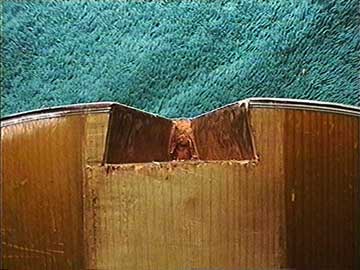Dovetail
© Frank Ford, 9/27/98 Photos by FF
One of the coolest pieces of traditional wood joinery is the famous "dovetail" joint.
Here, let me pull out the upper drawer of my desk here:

See the dovetails joining the front to the side of the drawer?
FRETS.COM Illustrated Glossary
Well, it sort of looks like a bird tail. . .
Dovetail
© Frank Ford, 9/27/98 Photos by FF
One of the coolest pieces of traditional wood joinery is the famous "dovetail"
joint.
Here, let me pull out the upper drawer of my desk here:

See the dovetails joining the front to the side of the drawer?
By the way, this is one of those 1940s oak desks that were made in huge numbers for offices, schools, etc. The speckled wood of the side is beech, which is traditionally preferred for the sides of drawers. In addition to drawer sides, beech is widely used for curved chair backs because it is one of the most easily bent of all woods.
OK, back to instruments. This is the dovetail "pocket"
in the most classic of all fretted instruments, the Martin guitar:

Here's the mating part of the neck that gets glued into the dovetail pocket:

The tapered dovetail joint of a Martin guitar is so strong a design that it can be
assembled without glue, and the guitar strung and played. Once glued in, the dovetail
joint is one of the strongest attachments a neck can have.
Take a look at this Gibson mandolin dovetail joint, here viewed from the bottom after
the back of the instrument has been removed:

Notice the shim inserted to tighten the joint when the instrument was originally
assembled.
There are those who think that a dovetail neck joint makes an instrument sound better. In my experience, there is no correlation between the method of neck attachment and tone, as long as the neck is securely mounted, whether by dovetail, dowel, mortise or bolts.